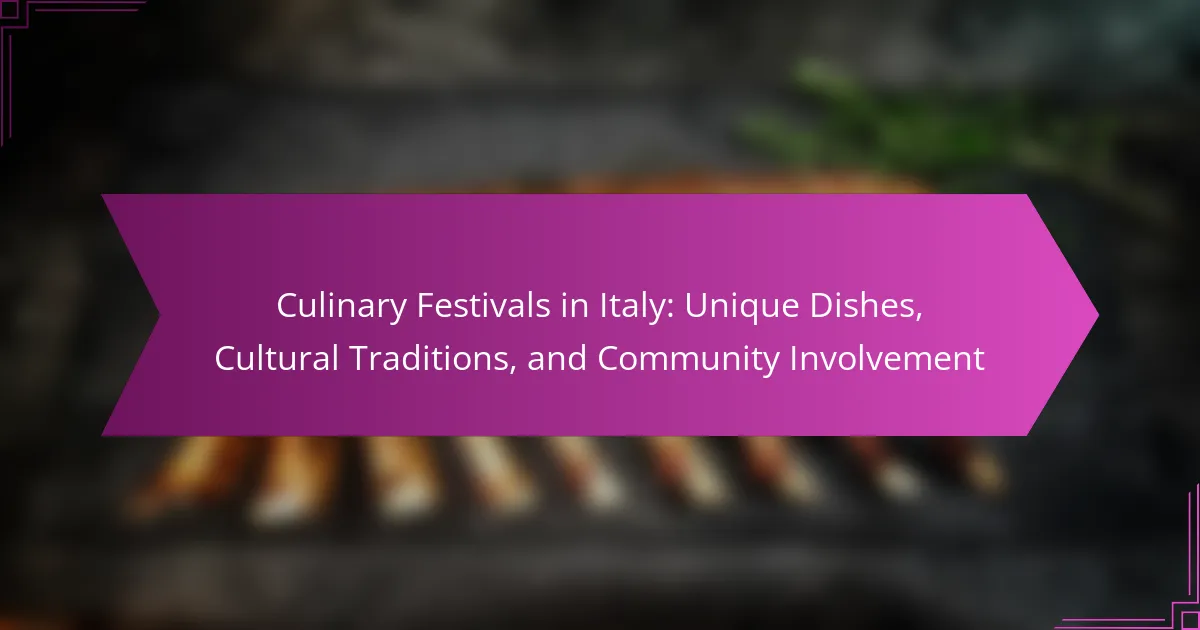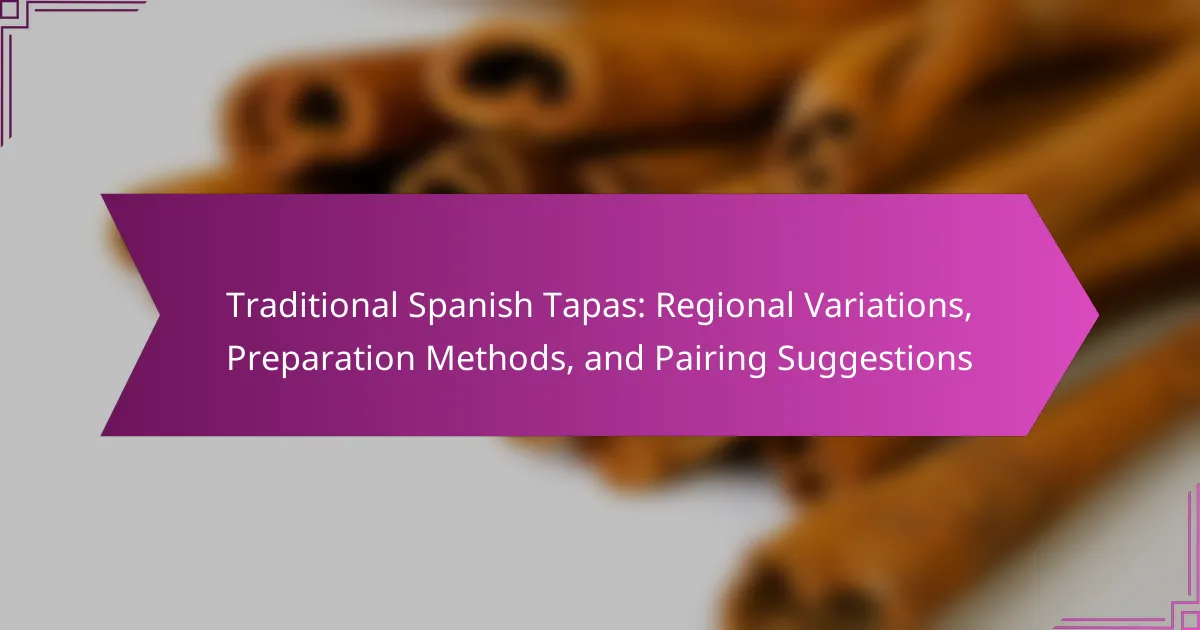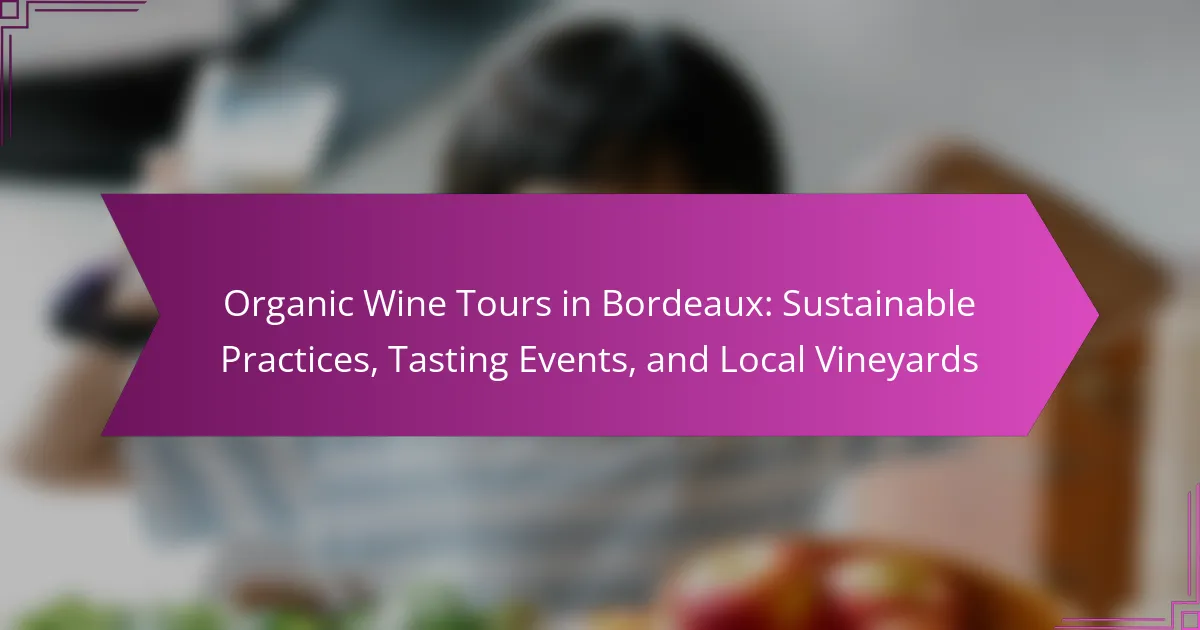Discover how sustainable culinary experiences in Tuscany enhance local flavours and traditions. Explore the use of local ingredients, traditional cooking techniques, and the cultural significance behind these practices. Learn about essential ingredients like olive oil and tomatoes, and understand how chefs navigate sustainability challenges. Engage with farm-to-table dining, cooking classes, and food festivals that celebrate Tuscany’s culinary heritage.
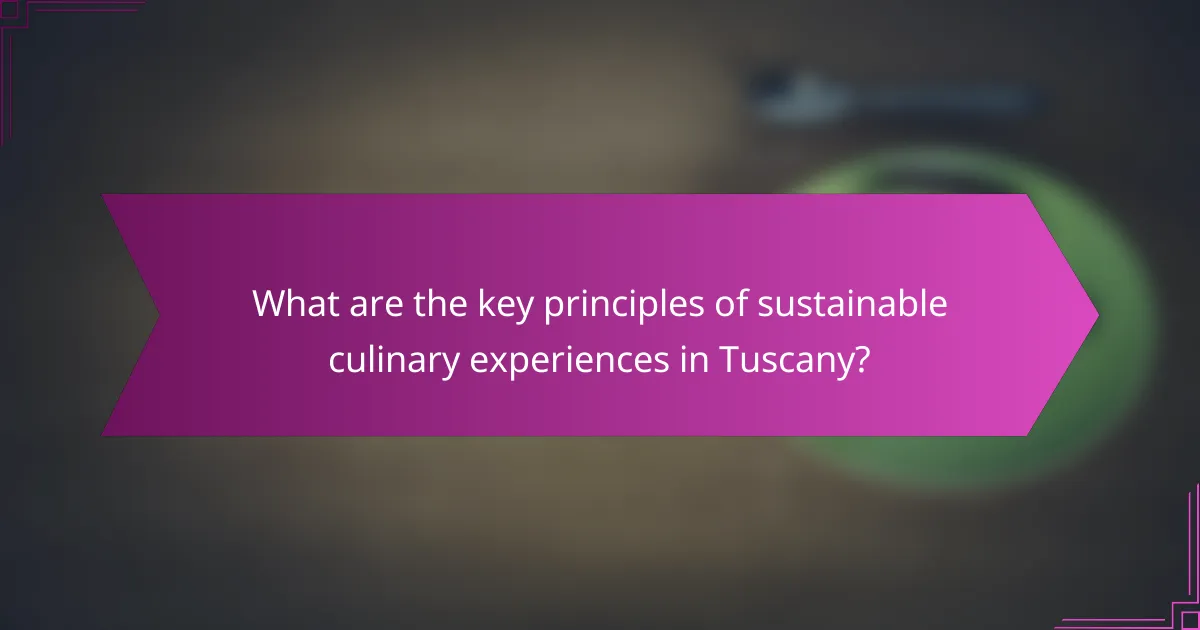
What are the key principles of sustainable culinary experiences in Tuscany?
Sustainable culinary experiences in Tuscany emphasise local ingredients, traditional cooking techniques, and cultural significance. These principles foster environmental stewardship, community support, and culinary heritage preservation.
Local ingredients form the foundation of Tuscan cuisine, highlighting seasonal produce, artisanal cheeses, and regional meats. This practice reduces carbon footprints and supports local farmers.
Traditional cooking techniques, such as slow roasting and wood-fired baking, enhance flavours while promoting sustainable practices. These methods often require less energy and respect the integrity of ingredients.
Cultural significance is evident in food festivals and communal meals, which celebrate local traditions and foster community connections. This aspect reinforces the importance of food in social and cultural contexts, enhancing the overall dining experience.
How do local ingredients contribute to sustainability?
Local ingredients significantly enhance sustainability by reducing transportation emissions and supporting local economies. They foster biodiversity and promote traditional farming practices. In Tuscany, the use of seasonal produce minimises environmental impact while preserving cultural heritage. This approach not only sustains local ecosystems but also enriches culinary experiences with authentic flavours.
What role do traditional cooking techniques play in sustainable cuisine?
Traditional cooking techniques are essential in sustainable cuisine as they promote local ingredients and minimise waste. In Tuscany, these methods highlight the region’s agricultural heritage and foster community connections. Techniques like slow cooking and fermentation enhance flavours while preserving seasonal produce. This approach not only supports local farmers but also reduces the carbon footprint associated with transportation. By valuing traditional practices, chefs create dishes that reflect the cultural significance of the land and its resources.
Why is cultural significance important in culinary practices?
Cultural significance is crucial in culinary practices as it preserves traditions and enhances the dining experience. In Tuscany, local ingredients reflect the region’s history and identity, fostering a connection between food and culture. This relationship enriches sustainable culinary experiences, emphasising authenticity and respect for local customs. Culinary techniques passed down through generations showcase unique attributes, such as traditional methods of pasta making or olive oil production. These practices not only celebrate the region’s heritage but also promote environmental sustainability by prioritising local sourcing.
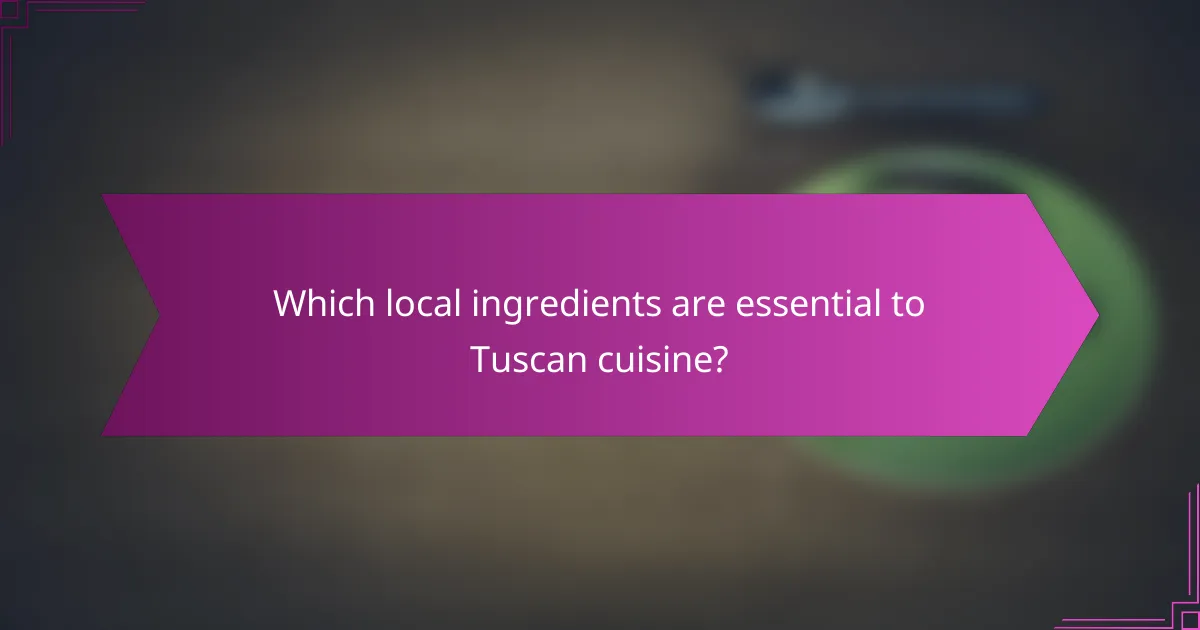
Which local ingredients are essential to Tuscan cuisine?
Essential local ingredients in Tuscan cuisine include olive oil, tomatoes, bread, beans, and herbs. These ingredients form the foundation of traditional dishes, emphasising regional flavours and sustainability.
Olive oil is a staple, known for its quality and health benefits, often used in dressings and cooking. Tomatoes, particularly San Marzano, add rich flavour to sauces. Tuscan bread, unsalted, complements meals and enhances local dishes. Beans, especially cannellini, provide protein and texture. Fresh herbs like rosemary and sage infuse dishes with aromatic qualities, showcasing Tuscan culinary traditions.
What are the seasonal variations in ingredient availability?
Seasonal variations significantly affect ingredient availability in Tuscany. Local produce aligns with the Mediterranean climate, resulting in distinct seasonal cycles.
Spring brings asparagus, artichokes, and peas. Summer showcases tomatoes, peppers, and basil. Autumn offers mushrooms, chestnuts, and pumpkins. Winter features root vegetables and citrus fruits.
This seasonal rhythm enhances culinary experiences, promoting sustainability through local sourcing. Chefs adapt techniques to highlight these ingredients, celebrating their cultural significance in Tuscan cuisine.
How do specific ingredients enhance flavour and nutrition?
Specific ingredients enhance flavour and nutrition by leveraging local biodiversity and traditional techniques. In Tuscany, ingredients like sun-ripened tomatoes and fresh basil provide rich flavours and essential nutrients. The use of olive oil, a staple, adds healthy fats and depth to dishes. Local cheeses contribute protein and unique taste profiles, while seasonal vegetables boost vitamins and minerals. Cooking methods, such as slow roasting or grilling, further intensify flavours, ensuring a sustainable culinary experience that honours the region’s cultural significance.
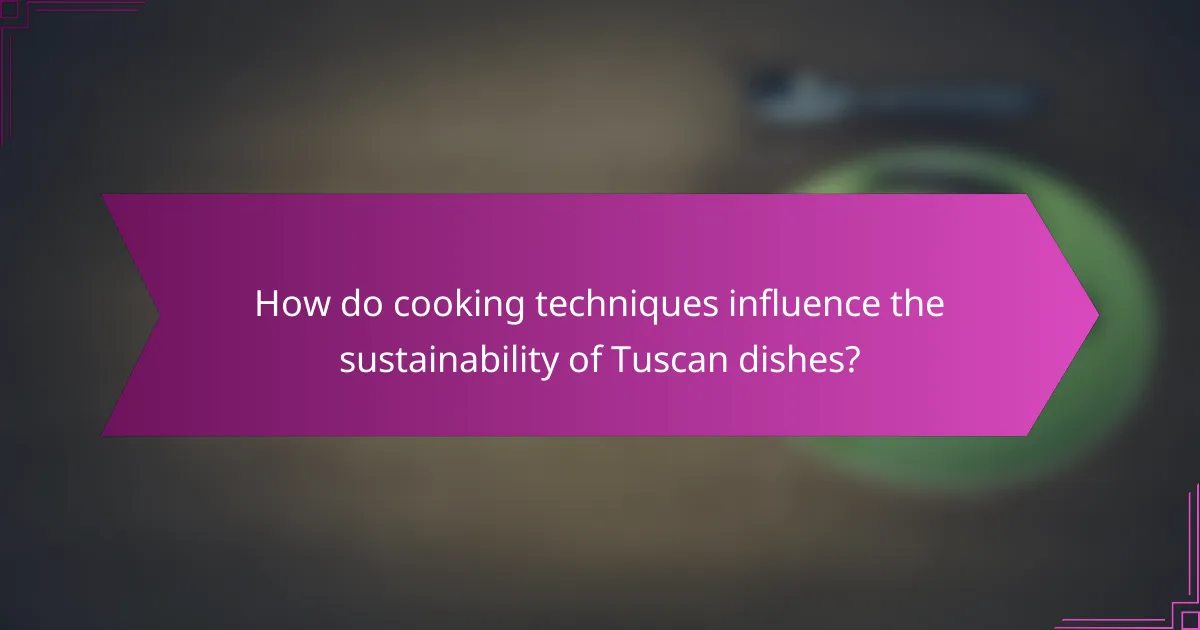
How do cooking techniques influence the sustainability of Tuscan dishes?
Cooking techniques significantly enhance the sustainability of Tuscan dishes by emphasising local ingredients and minimising waste. Traditional methods like slow cooking and using whole ingredients promote resource efficiency. For instance, braising allows tougher cuts of meat to become tender, reducing the need for more resource-intensive options. Additionally, techniques such as pickling and fermenting help preserve seasonal produce, further supporting local agriculture. This approach not only respects the environment but also enriches the cultural significance of Tuscan cuisine.
What traditional methods are used for food preservation?
Traditional methods for food preservation include drying, salting, pickling, fermenting, and smoking. These techniques enhance the longevity of local ingredients, reflecting Tuscany’s cultural significance.
Drying removes moisture, preventing spoilage. Salting draws out water and inhibits bacterial growth. Pickling involves soaking food in vinegar or brine, while fermenting utilises beneficial bacteria to create unique flavours. Smoking imparts flavour and preserves meats. Each method showcases sustainable practices rooted in Tuscan culinary traditions.
How does the cooking process affect ingredient quality?
Cooking processes significantly impact ingredient quality through heat application, moisture retention, and flavour enhancement. Traditional Tuscan techniques, such as slow roasting and simmering, preserve the integrity of local ingredients. These methods allow for maximum nutrient retention and deepen flavours, showcasing the region’s culinary heritage. Sustainable practices in cooking also emphasise the use of fresh, seasonal produce, ensuring that ingredients maintain their peak quality and nutritional value.

What cultural practices shape the culinary landscape in Tuscany?
Cultural practices in Tuscany significantly shape its culinary landscape through a focus on local ingredients, traditional cooking techniques, and deep-rooted customs. The use of seasonal produce, such as tomatoes and olive oil, reflects the region’s agricultural heritage. Cooking techniques, like slow roasting and wood-fired baking, enhance flavours while preserving authenticity. Festivals celebrating local food, such as the Sagra della Bistecca, highlight the cultural significance of cuisine in community life. These practices collectively promote sustainable culinary experiences that honour Tuscany’s rich traditions.
How do local festivals celebrate Tuscan culinary traditions?
Local festivals in Tuscany celebrate culinary traditions by showcasing regional ingredients and cooking techniques. These events highlight the cultural significance of food through communal meals, demonstrations, and tastings. For example, the Sagra del Tordo in Montalcino emphasises local game dishes, while the Fiera del Tartufo in San Miniato focuses on truffles. Such festivals foster connections between local producers and consumers, promoting sustainable practices and preserving culinary heritage. Additionally, these celebrations often feature traditional music and art, enriching the overall experience and reinforcing community bonds.
What is the impact of family recipes on local cuisine?
Family recipes significantly shape local cuisine by preserving culinary traditions and promoting the use of regional ingredients. These recipes often reflect the unique cultural heritage of Tuscany, showcasing local flavours and cooking techniques passed down through generations. As a result, they foster a sense of community and identity among residents. Furthermore, family recipes contribute to sustainable culinary experiences by encouraging the use of seasonal produce, reducing food waste, and supporting local farmers. This practice not only enhances the quality of dishes but also strengthens the local economy and promotes biodiversity.
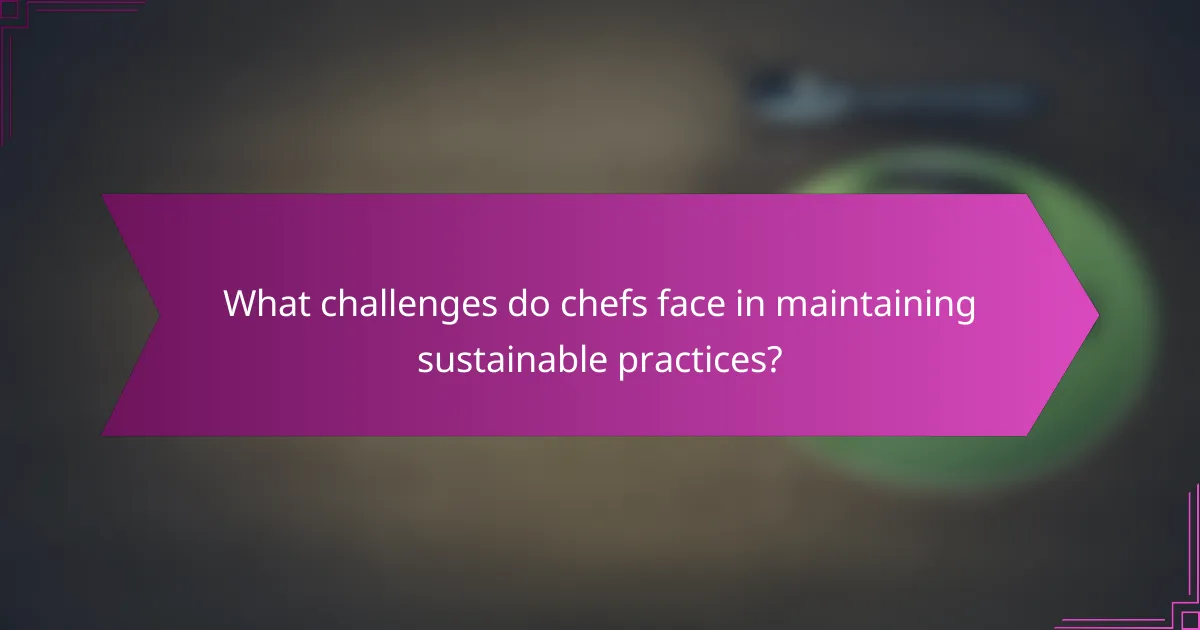
What challenges do chefs face in maintaining sustainable practices?
Chefs face several challenges in maintaining sustainable practices, including sourcing local ingredients, managing food waste, and adapting traditional cooking techniques. Limited availability of seasonal produce can hinder menu planning. Additionally, balancing cost and sustainability may lead to difficult choices. Cultural significance often clashes with modern sustainability goals, creating further complexity. Chefs must navigate these issues while striving for culinary excellence.
How do economic factors influence ingredient sourcing?
Economic factors significantly influence ingredient sourcing by determining availability, pricing, and sustainability of local products. The demand for local ingredients in Tuscany is shaped by consumer preferences for fresh, seasonal offerings and the impact of economic conditions on agricultural practices. For instance, fluctuations in market prices can affect farmers’ decisions on crop types, which in turn influences the culinary landscape. Additionally, economic incentives for sustainable farming practices can enhance the quality and cultural significance of local ingredients, promoting a deeper connection between cuisine and community.
What are the environmental impacts of modern culinary practices?
Modern culinary practices can significantly impact the environment through resource use and waste generation. Sustainable culinary experiences in Tuscany emphasise local ingredients, which reduce transportation emissions and promote biodiversity. Traditional cooking techniques often utilise seasonal produce, minimising energy consumption. Culturally significant practices, such as foraging and preserving, foster a connection to the land, encouraging responsible consumption. Adopting these methods can lead to lower carbon footprints and enhanced ecological balance.

How can tourists engage with sustainable culinary experiences in Tuscany?
Tourists can engage with sustainable culinary experiences in Tuscany by participating in farm-to-table dining, local cooking classes, and food festivals. These activities highlight the use of seasonal ingredients and traditional cooking techniques.
Farm-to-table dining emphasises locally sourced produce, reducing carbon footprints and supporting local farmers. Cooking classes offer hands-on experience with authentic Tuscan recipes, showcasing unique attributes like handmade pasta and regional wines. Food festivals celebrate local culinary traditions, providing opportunities to taste and learn about the cultural significance of dishes.
By immersing themselves in these experiences, tourists not only enjoy delicious food but also contribute to the preservation of Tuscany’s culinary heritage.
What are the best local markets for sourcing ingredients?
The best local markets for sourcing ingredients in Tuscany include Mercato Centrale in Florence, the weekly market in Siena, and the farmer’s market in Lucca. These markets offer fresh, seasonal produce, artisanal cheeses, and local meats, enhancing sustainable culinary experiences. Mercato Centrale features a variety of vendors, while the Siena market is known for its vibrant atmosphere and local specialities. Lucca’s farmer’s market emphasises organic products, reflecting the region’s commitment to sustainability.
Which cooking classes promote sustainable techniques?
Sustainable cooking classes in Tuscany focus on local ingredients and traditional techniques. These classes emphasise farm-to-table practices, seasonal cooking, and minimising waste. Participants learn to prepare dishes using organic produce and sustainable seafood, fostering a deeper connection to the region’s culinary heritage.
What are the common mistakes to avoid when exploring Tuscan cuisine?
To explore Tuscan cuisine effectively, avoid common mistakes like neglecting local ingredients, overlooking traditional cooking techniques, and ignoring the cultural significance of dishes. Emphasising local produce enhances sustainability and authenticity. Many visitors fail to appreciate the importance of seasonality in ingredient selection, which can lead to subpar culinary experiences. Additionally, skipping regional specialities may result in missed opportunities to connect with Tuscan heritage. Prioritise understanding the context of each dish to fully appreciate its flavours and history.
